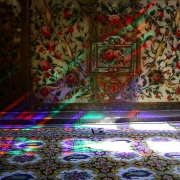Iran Must See Wonders
Iran Must See Wonders!
Iran, known as Persia until 1935, is a partly undiscovered gem. It offers rich culture, history and provides visitors with impressive heritage. Iran ranks seventh among countries in the world as regards the number of World Heritage Sites recognized by UNESCO. Historical and urban settlements date back to 4000 BC in this area. Locals are called Persians and represent about 51% of the population. Tourism-review.com, in collaboration with prominent Iranian tour operator kalouttour, introduce the best, most famous, historical and prominent places of the “Land of the Aryan’s” – the 7 wonders of Iran.
Persepolis
Once the thriving cultural and art center of Iran, today Persepolis is considered one of the most beautiful historical locations in the world. The ancient city, situated 60 km northeast of the city Shiraz, had long been buried under the sand for centuries until its discovery in the 1930s by Erich Frederich Schmidt and his colleagues.
It was founded by Darius I in 518 B.C. and served as the capital of the Archaemenid Empire. The ruins of Persepolis, which burnt down at the order of Alexander the Great, are considered one of the world’s greatest archaeological sites and is also registered as a UNESCO Heritage Site.
Shah Mosque
Created during the Safavid era, the Shah Mosque, also known as Imam Mosque, is situated in the south side of the Naghsh-e Jahan Square. The square is in the center of the city Isfahan. Its construction began in 1611 and the mosque represents the culmination of a thousand years of mosque building.
It is a remarkable example of the diversity of Iranian architecture, with its seven-color mosaic tiles and calligraphic inscriptions being the highlights. The port of the mosque measures 27 m high and is crowned with two 42 m tall minarets. It is also surrounded by four iwans and arcades. The Shah Mosque, one of the seven wonders of Iran, is also registered as a UNESCO Heritage site.
Haft Tepe
Haft Tepe is located 15 km to the south of the ancient city of Susa. It is one of Iran’s most significant archaeological sites and the remains of the ancient Elamite city of Kabnak were discovered here. It is composed of seven ancient mounds. The site was first excavated by French archaeologist Jacques de Morgan, with Iranian Ezzat Negahban continuing work in the second half of the 20th century.
Excavations on the site revealed a large temple founded by Tepti-Ahar where the god Kirwashir was worshiped. Below the temple lay a funerary complex for the king and his family, with skeletal remains found in the tomb. Other than that, structures reminding of the foundations of a ziggurat were found here, along with courtyards and suites of rooms.
Naqsh-e Jahan Square
Naqsh-e Jahan Square is a square located in the center of the city of Asfahan. It was constructed between 1598 and 1629 and is now a very important historical site and one of Iran’s many UNESCO World Heritage Sites. It is 160 meters wide and 560 meters long. The square is bordered by two -story arcades and surrounded by many buildings from the Safavid era, such as the already mentioned Shah Mosque, the Ali Qapu Palace or the Mosque of Sheykh Loftollah. It is one of the largest city squares in the world and another great example of Iranian and Islamic architecture.
Eram Garden
The Eram Garden, another of the seven wonders of Iran, is a historical Persian garden located in Shiraz. The whole complex is located at the northern shore of the Khoshk River in the Fars province. The word “Eram” is the Persian version of the Arabic word “Iram” which means heaven in the Quran.
No one is quite sure when construction of the beautiful complex began, but it is suggested that the gardens were built during the Seljuk Dynasty (11th – 14th centuries) under the rule of Ahmad Sanjar. Later it was repaired by the Zand kings of the Zand Dynasty in the second part of the 18th century. Many more rulers decided to improve the gardens, with the Qajar Dynasty leading constructions to what now stands in the gardens: beautiful flowers, refreshing air, myrtles and enormous cypress trees surrounded by typical Iranian architecture.
Nasir ol Molk Mosque
The Nasir ol Molk Mosque, nicknamed the Pink Mosque, is a traditional mosque located in Shiraz. It was built between 1876 and 1888 during the Qajar era. What makes it unique and beautiful is the extensive use of stained glass in its facade, with many pink tiles as well.
It also displays other traditional elements, such as Panj Kase (“five concaved”) design. The best time to visit the mosque is in the morning, when the sun rises over Shiraz. During this time, the sunlight bursts through the windows and illuminates the walls and floors of the mosque with beautiful colors.
Vank Cathedral
The Vank Cathedral, also known as the Church of Saintly Sister, is a cathedral located in the New Julfa district, specific for its predominant Christian community, in the city of Isfahan. Construction began in 1606 during the Safavid period, but in 1655 the Armenian church was rebuilt to adapt to the growing Christian community in the city. A tilework plaque inscribed in Armenian can be seen by the entrance to the cathedral.
The cathedral’s interior is a prime example of the mixture of Islamic and Christian style. The interior is covered with frescos and gilded carvings as well as wainscot of rich tile work. The courtyard contains a large belfry towering over the graves of both Orthodox and Protestant Christians. In one corner, there is also a memorial to the Armenian Genocide in Turkey.



